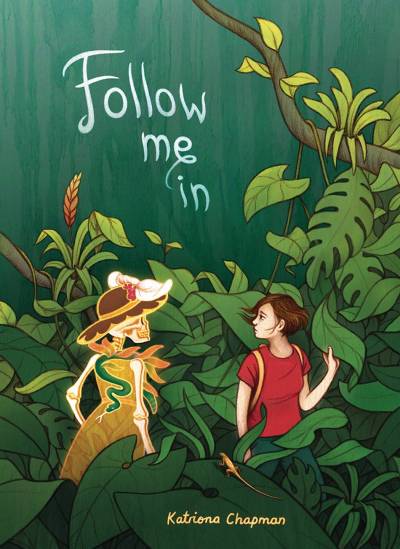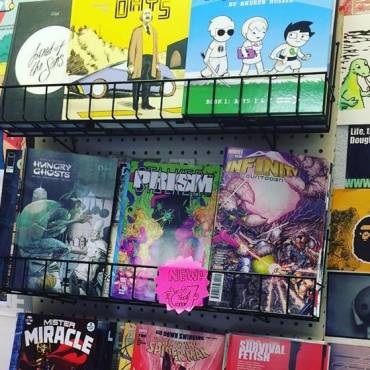Follow Me In is Katriona Chapman’s debut book from UK publisher Avery Hill. It details a transformative trip to Mexico with her then-boyfriend and focuses on the details of the trip as well as her ambivalence toward her boyfriend thanks to his alcoholism. Best known for her autobio minicomics, the book doubles both as a chronicle of the event that gave her the confidence to do comics and the actual, eventual product of that experience. It’s a bold and ambitious first book that is slowly paced and features odd breaks in the narrative to educate the reader regarding historical and anthropological facts about Mexico. It demands the reader accepts the book on Chapman’s terms for pacing and storytelling. The title reflects that: “Follow Me In”. Buy the ticket, take the ride.
There’s interesting push-and-pull at work in this book. The narrative is restrained, even when examining emotionally difficult topics. Chapman never allows the book to devolve into melodrama, but she also doesn’t ignore the issues surrounding her boyfriend. On the other hand, Chapman channels all of that churning emotion into the spectacular use of colored pencils on every page. If the narrative’s affect is restrained almost to the point of flatness; the richness and depth of her color demands that the reader slow down and luxuriate in each panel. This isn’t a case of a story being led by one or two bright colors, a la the NoBrow aesthetic. Rather, Chapman saturates each page with a wide but tasteful array of colors. This is obvious in sequences set in nature where she’s looking at beautiful scenery, but it’s just as clear in less exciting settings. Her use of color subtly but clearly modulates and sometimes amplifies the emotional content of the story. She pulls back at times so as not to make this too glaringly obvious, but the joy and vibrancy she felt in her surroundings is depicted on the page along with her ambivalence.
In many respects, this is a coming-of-age narrative as well as the origin story of Chapman’s career as a cartoonist. Her plan was to take her sketchbook along with her to Mexico and start drawing again. This is a powerful part of the narrative, but her first attempts are faltering. Her lack of confidence made her self-conscious about what she was doing. As she kept at it, the practice proved transformative. Suddenly, her hands were a conduit to a part of her brain that was able to take what she saw and fluidly render them on the page. She described it as her drawings just starting to pour out of her as she was inspired by her environment and the people she met. The other thing she learned is that as much as she loved her boyfriend, it is impossible to try to control the actions of an addict. First, she had to come to terms with the fact that her boyfriend was a binge alcoholic. He didn’t drink all the time, but when he did, it was to extreme excess. She realized that she had to stop hoping that “this time is the last time” when he didn’t drink for a while. More to the point, her scolding him had no effect on his behavior, other than reinforcing his self-hatred and pushing him further into addiction. Ignoring him or cajoling him didn’t help either. The decision as to whether or not he wanted to be an alcoholic was his alone. Her only role, as she came to understand, was to let him do make that decision was erecting some healthy barriers.
The book’s framing device is that of her meeting her now ex-boyfriend ten years after the trip to discuss the book. He gives his approval as they catch up in a setting in England that’s deliberately made to look gray. Flip the page, and the reader is not only transported back to the past but also into a vibrant, exciting landscape. One of the book’s key strengths is its lack of romanticizing the foreign setting. Indeed, both came in having done a lot of research, and their interest was not only historical and anthropological, it took into account that simply being tourists was disruptive. It’s one of many contradictions the book addresses but leaves open. Countries like Mexico depend on tourists as a significant part of their economy, but tourists are often boorish or even destructive. Chapman focuses on that point when a tour guide led them on a Day of the Dead tour.
Chapman’s narrative is even-handed. There are stories about illness and the roughness of travel that serve to really spill some ink about the experience. There’s no pretending things were glamorous, but there weren’t any complaints, either. You pay the ticket, you take the ride. It’s the credo of this book, for both artist and reader. Follow me in, and let’s see where we go. Their itinerary was ambitious, hitting a number of small towns and remote areas in Mexico. Some of them forbade cameras, rightfully distrusting outsiders. Throughout the book, Chapman throws in several pages of factoids about Mexican history, culture and archaeology. While beautifully illustrated, they are dense and force the reader to slow down in order to read them. Chapman throws these breaks in deliberately to break up the narrative and alert the reader that one of the book’s goals is to educate. The fact that Mexico is made up of so many languages and ethnic groups is deeply ingrained in the book’s structure, and the breaks serve both as palate cleanser and information guide. There are times when this approach slows down a deliberately-paced book even more, but it’s reflective of her experience.
Ultimately, Follow Me In is reflective of not just a journey, but of a great deal of time spent thinking about that journey. She couldn’t not write about her boyfriend because he was a big part of the story, but she had to be honest about her ambivalence toward him. That ambivalence led to a break-up later on. The framing device allows the audience to be made privy of this fact without focusing on it. The break-up is not part of the story of the trip, but knowing about it is an important part of closure for the reader. The book’s even-handed quality also allows Chapman to embrace the fact that parts of the trip with him were fantastic, like a memorable mushroom experience or long, invigorating hikes. The emotional even-handedness of the book allows Chapman to focus on the visceral qualities of the trip itself: the heat, the exhaustion, the beauty of the beaches, the food they try, the people that they meet. It’s all in a heightened state of awareness, as the familiar and comfortable were left behind. It’s a narrative that has its bumps and wobbles as a reader, but that’s all part of the experience. It was one well worth taking.








